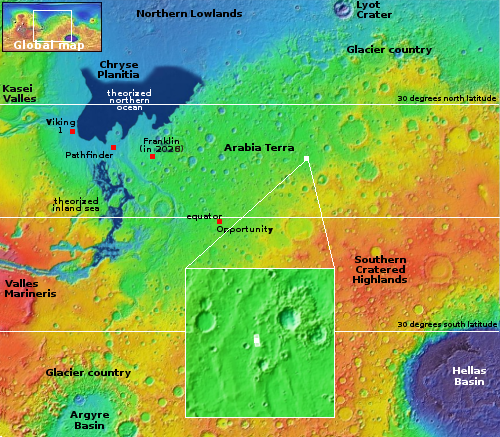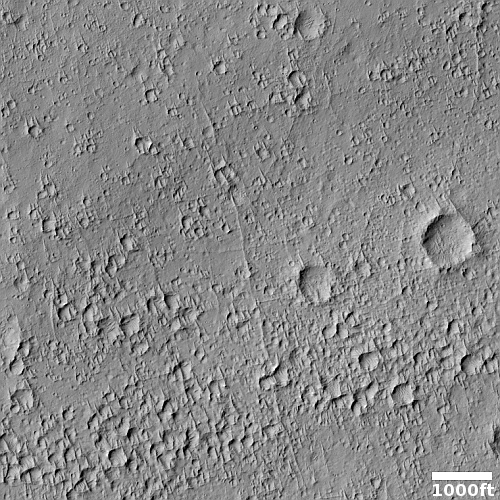The wind-scoured dusty and cratered dry tropics of Mars
Cool image time! The picture to the right, cropped, reduced, and sharpened to post here, was taken on June 2, 2023 by the high resolution camera on Mars Reconnaissance Orbiter (MRO), and shows one small area in Martian equatorial regions where the main features are a dusty plain interspersed with craters, not entirely dissimilar to the Moon .
In the picture the northwest-to-southeast orientation of ridge-lines, plus the position of divots with their steep and deep end all on the northwest side, all suggest the prevailing winds here blow in the same direction, from the northwest to the southeast.
We are looking at a very ancient terrain. Many of these craters likely date from the early bombardment period of the solar system, just after the planets had formed but there was still a lot of objects around crashing into them.

The white dot on the overview map to the right marks the location, within Arabia Terra, the largest transition zone region on Mars between the northern lowland plains and the southern cratered highlands.
Much of Arabia shows evidence of shield volcano events as well as the possibility of lakes existing once in the distant past within many of its craters. There is also evidence of glacier activity that might have formed some of its meandering canyons.
This photo merely tells us that there is a lot of dust in Arabia Terra as well, piling up on the surface in many places only to be disturbed later by wind. Much of this dust is believed to have been blown halfway around the planet from the Medusa Fossae Formation, the largest volcanic ash field on Mars.
The picture also illustrates the dryness of Mars equatorial regions. This is the tropics of Mars, but unlike the Earth it is anything but wet.
On Christmas Eve 1968 three Americans became the first humans to visit another world. What they did to celebrate was unexpected and profound, and will be remembered throughout all human history. Genesis: the Story of Apollo 8, Robert Zimmerman's classic history of humanity's first journey to another world, tells that story, and it is now available as both an ebook and an audiobook, both with a foreword by Valerie Anders and a new introduction by Robert Zimmerman.
The print edition can be purchased at Amazon or from any other book seller. If you want an autographed copy the price is $60 for the hardback and $45 for the paperback, plus $8 shipping for each. Go here for purchasing details. The ebook is available everywhere for $5.99 (before discount) at amazon, or direct from my ebook publisher, ebookit. If you buy it from ebookit you don't support the big tech companies and the author gets a bigger cut much sooner.
The audiobook is also available at all these vendors, and is also free with a 30-day trial membership to Audible.
"Not simply about one mission, [Genesis] is also the history of America's quest for the moon... Zimmerman has done a masterful job of tying disparate events together into a solid account of one of America's greatest human triumphs."--San Antonio Express-News
Cool image time! The picture to the right, cropped, reduced, and sharpened to post here, was taken on June 2, 2023 by the high resolution camera on Mars Reconnaissance Orbiter (MRO), and shows one small area in Martian equatorial regions where the main features are a dusty plain interspersed with craters, not entirely dissimilar to the Moon .
In the picture the northwest-to-southeast orientation of ridge-lines, plus the position of divots with their steep and deep end all on the northwest side, all suggest the prevailing winds here blow in the same direction, from the northwest to the southeast.
We are looking at a very ancient terrain. Many of these craters likely date from the early bombardment period of the solar system, just after the planets had formed but there was still a lot of objects around crashing into them.

The white dot on the overview map to the right marks the location, within Arabia Terra, the largest transition zone region on Mars between the northern lowland plains and the southern cratered highlands.
Much of Arabia shows evidence of shield volcano events as well as the possibility of lakes existing once in the distant past within many of its craters. There is also evidence of glacier activity that might have formed some of its meandering canyons.
This photo merely tells us that there is a lot of dust in Arabia Terra as well, piling up on the surface in many places only to be disturbed later by wind. Much of this dust is believed to have been blown halfway around the planet from the Medusa Fossae Formation, the largest volcanic ash field on Mars.
The picture also illustrates the dryness of Mars equatorial regions. This is the tropics of Mars, but unlike the Earth it is anything but wet.
On Christmas Eve 1968 three Americans became the first humans to visit another world. What they did to celebrate was unexpected and profound, and will be remembered throughout all human history. Genesis: the Story of Apollo 8, Robert Zimmerman's classic history of humanity's first journey to another world, tells that story, and it is now available as both an ebook and an audiobook, both with a foreword by Valerie Anders and a new introduction by Robert Zimmerman.
The print edition can be purchased at Amazon or from any other book seller. If you want an autographed copy the price is $60 for the hardback and $45 for the paperback, plus $8 shipping for each. Go here for purchasing details. The ebook is available everywhere for $5.99 (before discount) at amazon, or direct from my ebook publisher, ebookit. If you buy it from ebookit you don't support the big tech companies and the author gets a bigger cut much sooner.
The audiobook is also available at all these vendors, and is also free with a 30-day trial membership to Audible.
"Not simply about one mission, [Genesis] is also the history of America's quest for the moon... Zimmerman has done a masterful job of tying disparate events together into a solid account of one of America's greatest human triumphs."--San Antonio Express-News



Looking over the original picture, I see no distinguishing or unusual features. It’s a very bleak landscape. A high flat top Mesa in the lower right… A Future outpost location.
The only feature that is barely worth mentioning is a recent landslide? Or unusual massive slope streak from the cliffs edge into the large depression/basin on the upper left. Most of this area is in shadow and difficult to distinguish.